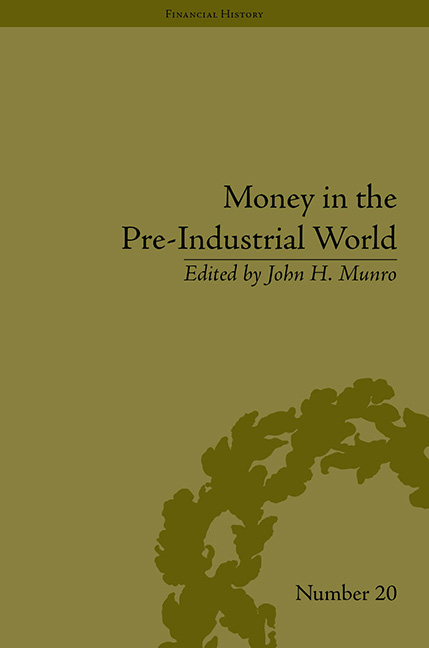Book contents
- Frontmatter
- CONTENTS
- List of Figures and Tables
- List of Contributors
- Introduction
- 1 The Technology and Economics of Coinage Debasements in Medieval and Early Modern Europe: with Special Reference to the Low Countries and England
- 2 From Aurelian to Diocletian: Financing Imperial Recovery by Coinage Debasements and Fiduciary Currencies
- 3 The Making of a Gold Standard: The Ducat and its Offspring, 1284–2001
- 4 Debasement of the Coinage and its Effects on Exchange Rates and the Economy: in England in the 1540s, and in the Burgundian-Habsburg Netherlands in the 1480s
- 5 The Amsterdam Wisselbank's Innovations in the Monetary Sphere: The Role of ‘Bank Money’
- 6 Silver in England 1600–1800: Coinage Outputs and Bullion Exports from the Records of the London Tower Mint and the London Company of Goldsmiths
- 7 The Burdens of Tradition: Debasements, Coinage Circulation and Mercantilist Public Policy Debates in Seventeenth-Century Aragon
- 8 Money or Export Commodity for Asia? American Silver in the Markets of Mexico, Castile and Amsterdam from the Sixteenth to the Eighteenth Century
- 9 Cacao Beans in Colonial México: Small Change in a Global Economy
- 10 Precious Metals, Debasements and Cowrie Shells in the Medieval Indian Monetary Systems, c. 1200–1575
- Notes
- Index
5 - The Amsterdam Wisselbank's Innovations in the Monetary Sphere: The Role of ‘Bank Money’
- Frontmatter
- CONTENTS
- List of Figures and Tables
- List of Contributors
- Introduction
- 1 The Technology and Economics of Coinage Debasements in Medieval and Early Modern Europe: with Special Reference to the Low Countries and England
- 2 From Aurelian to Diocletian: Financing Imperial Recovery by Coinage Debasements and Fiduciary Currencies
- 3 The Making of a Gold Standard: The Ducat and its Offspring, 1284–2001
- 4 Debasement of the Coinage and its Effects on Exchange Rates and the Economy: in England in the 1540s, and in the Burgundian-Habsburg Netherlands in the 1480s
- 5 The Amsterdam Wisselbank's Innovations in the Monetary Sphere: The Role of ‘Bank Money’
- 6 Silver in England 1600–1800: Coinage Outputs and Bullion Exports from the Records of the London Tower Mint and the London Company of Goldsmiths
- 7 The Burdens of Tradition: Debasements, Coinage Circulation and Mercantilist Public Policy Debates in Seventeenth-Century Aragon
- 8 Money or Export Commodity for Asia? American Silver in the Markets of Mexico, Castile and Amsterdam from the Sixteenth to the Eighteenth Century
- 9 Cacao Beans in Colonial México: Small Change in a Global Economy
- 10 Precious Metals, Debasements and Cowrie Shells in the Medieval Indian Monetary Systems, c. 1200–1575
- Notes
- Index
Summary
Introduction
From its very foundation, the Amsterdam Wisselbank has been praised by bankers as well as by scholars for its pre-eminent role in early-modern national monetary policies and international finance. In 1776 Adam Smith called it ‘the great warehouse of Europe for bullion’ and more recently Simon Schama described it as the ‘watchdog of capitalism in Amsterdam’, the ‘church of Dutch capitalism’. In ‘European Banking in the Middle Ages and Early Modern Times’, in A History of European Banking, I put forward the hypothesis that in the early-modern period the Low Countries produced an autonomous Financial Revolution, one that should be considered as a crucial link between the late-medieval Italian Financial Revolution and the eighteenth-century English Financial Revolution. I also suggested that the real innovations, as far as financial techniques were concerned, occurred in Antwerp during the sixteenth century. In this hypothesis the Amsterdam Wisselbank was, from a technical point of view, a primarily conservative institution, simply following the Italian banking traditions of the fifteenth and sixteenth centuries. If innovations in financial techniques did occur in Amsterdam during its Golden Age, they originated mainly in the sectors of private banking.
The purpose of this chapter, therefore, is to explore to what extent this thesis is still valid or, on the contrary, has to be restated or revised on the basis of recent research. No spectacular new discoveries will be revealed, but this chapter attempts to combine the new insights of the many scholars who have studied these problems in recent years, and to connect their findings with my own hypothesis. While this chapter examines early modern banking institutions, and related innovations in credit instruments, it also provides a clear link with the previous studies on coinage debasements in this volume. For one of the most pressing, indeed urgent, concerns in both the private and the public spheres of the new Dutch republic (created in 1579, as the United Provinces, to use its more formal title) was how the government, bankers, merchants and money dealers would deal with the problem of an increasing circulation of foreign coins generated by Dutch regional and foreign trade: a circulation that contained a large proportion of debased and counterfeit coins, to the extent that, by the early seventeenth century, public confidence in the coinage system was being seriously undermined.
- Type
- Chapter
- Information
- Money in the Pre-Industrial WorldBullion, Debasements and Coin Substitutes, pp. 87 - 96Publisher: Pickering & ChattoFirst published in: 2014



